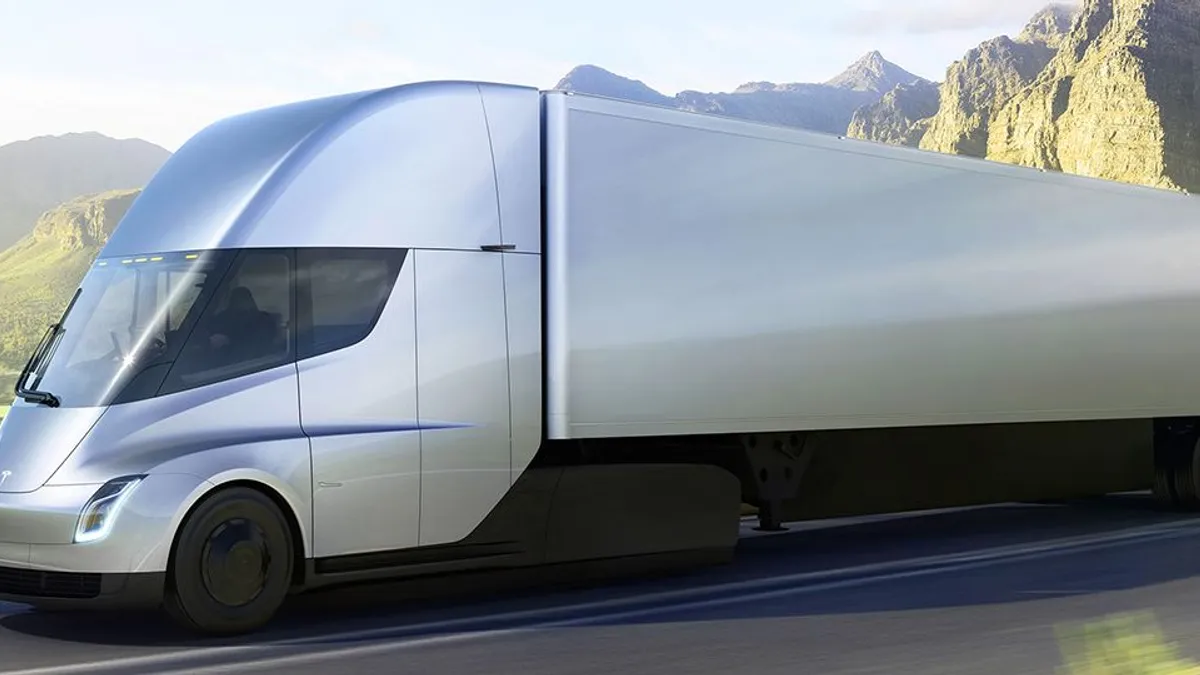Dive Brief:
- "We need more cells," Tesla's Elon Musk said of Tesla Semi production during the company's Q3 earnings call last week. The truck's power source has been, and continues to be, a major obstacle in scaling manufacturing.
- "We need to solve the cell constraint before ramping Semi to significant volume. That's the only real constraint on Semi's progress," Musk said. Tesla said it still plans for initial deliveries to occur next year.
- Tesla President of Automotive Jerome Guillen said the company is collaborating with others on charging infrastructure, though did not specify details. "We're not working in isolation," he said. "We're working with other parties to make sure that there is a standard infrastructure that will be able to be deployed for all customers."
Dive Insight:
Fleets will have at least three electric options in 2021 — if the manufacturers stay on schedule. Not only should Tesla's offering be ready for delivery in 2021, but Volvo's VNR Electric should be available for lease that year. Daimler Trucks' Mercedes-Benz eActros LongHaul and Kenworth's Class 8 T680E are slated to enter into production.
Tesla's 2021 Semi delivery target is a delay from its originally planned 2019 delivery.
"The technology that we're putting into Semi is identical to what we're putting in other vehicles," Tesla CFO Zach Kirkhorn said on the Q3 call.
"Yes," Musk added, "it's just bigger and more motors."
But it's precisely that which makes scaling production of the Class 8 electric truck difficult. The Semi requires "five-ish times" more cells than a passenger vehicle, Musk said. "It's difficult to ramp up the Semi because there's no cells."
Accelerating production of one vehicle would take battery resources away from another, Musk said.
"We found over and over again, we just kept running into cell production limitations. And then we're just taking things out of one pocket and putting them in another," Musk said.
Tesla has been aiming to "rethink batteries from scratch," Musk said during the call. The company unveiled a product during its Battery Day in September that should benefit the Semi with improved density, cost per kilowatt and manufacturing efficiency — just not until 2022.
Kirkhorn said during the call last week that Tesla raised its expectation for capital spending in 2021 and 2022 by $2 billion, driven by expansion in battery cell factories and other investments to expand battery manufacturing capacity.
The "bigger and more motors" reality of the Semi also means the charging technology Tesla currently has is not sufficient to scale for Class 8 operations.
Guillen said Tesla is looking to achieve range and charging speed that would allow truck drivers to recharge on their breaks.
"We have to invent it because it doesn't exist. But we're trying to invent something that could be helpful for everybody," he said.
Electric truck technology for some operations is far along in development. But infrastructure lags. Original equipment manufacturers (OEM), utilities, charging companies and even government bodies have been pooling resources to expedite an answer to the charging question.
California is perhaps in the greatest hurry to get green trucks on the road. It has implemented the most disruptive carbon-cutting rules in the country, but it has also been open to funding programs that can help get equipment to market.
The California South Coast Air Quality Management District recently awarded Volvo Trucks North America a $1.7 million grant for charging infrastructure as part of a program that has the OEM deploying 70 Class 8 electric trucks. And nine utilities and two agencies representing 24 municipal utilities on the West Coast have proposed electric-charging stations for trucks every 50 miles along Interstate 5 and connecting highways.
On the OEM front, Lion Electric is partnering with ABB to sell and service charging equipment. And Navistar and In-Charge Energy have teamed up on consulting services and internal charging infrastructure.















